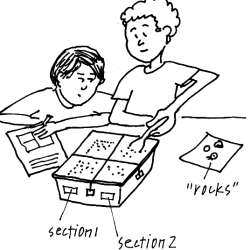Source Institutions
Source Institutions
Add to list Go to activity
Activity link broken? See if it's at the internet archive

In this activity (on pages 30-36), learners simulate a dig for ancient pollen, to experience how paleobotanists study fossilized pollen in rocks to learn about early geological and climatological events on earth. Learners search in a "dig site" to find rocks, then carefully extract "seeds" from the imitation rocks (which must be made ahead of time). They record their data to understand the process scientists use in understanding the ancient earth.
- 2 to 4 hours
- 1 to 2 hours
- $10 - $20 per group of students
- Ages 8 - 14
- Activity, Model, Simulation
- English, Spanish
Quick Guide
Materials List (per group of students)
- 4 dissecting needles
- 4 plastic pipets or droppers
- 4 plastic spoons
- masking tape
- paper towels
- 2 pieces of string, each 35 cm
- 1/4 cup vinegar in a small plastic cup
- aluminum cake pan 8 x 8 inch filled 3/4 full with dry sand and 4 imitation rocks made from:
- About 1/2 oz Indian seed beads (2 packets) in the following colors: yellow, white, oragne, red, green, blue, and black
- 1 1/2 cup flour
- 1/2 cup salt
- 4 tsp. Alum
- 3/4 cup baking soda
- 1 cup sand with small gravel
- 3/4 cup water
- 4-5 drops red, blue and yellow food coloring
- mixing bowl
- cookie sheet
- oven
Subjects
-
Earth and Space Science
-
Earth Structure
- Rocks and Minerals
-
Earth's History
- Archeology
- Fossils
-
Earth Structure
-
Life Sciences
-
Diversity of Life
- Plants
-
Diversity of Life
-
The Nature of Science
-
The Scientific Process
- Asking Questions
- Conducting Investigations
- Gathering Data
- Science as a Career
-
The Scientific Process
Informal Categories
- Outdoor Activity
Audience
To use this activity, learners need to:
- see
- see color
- touch
Learning styles supported:
- Involves teamwork and communication skills
- Involves hands-on or lab activities
Designed specifically for
- Rural dweller
Culture, ethnicity, and gender
-
Girls
- Explicity developed for this group
Other
Foreign language versions of this resource:
Components that are part of this resource:
Includes alignment to state and/or national standards:
This resource is part of:
Access Rights:
- Free access
By:
Source Collection
- Science After School Consumer's Guide
Rights:
- All rights reserved, University of Nebraska State Museum, 2001
Funding Sources:
- National Science Foundation Informal Science Education Program, 9909496
- Howard Hughes Medical Institute
